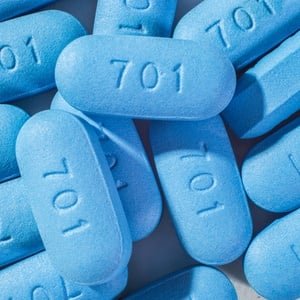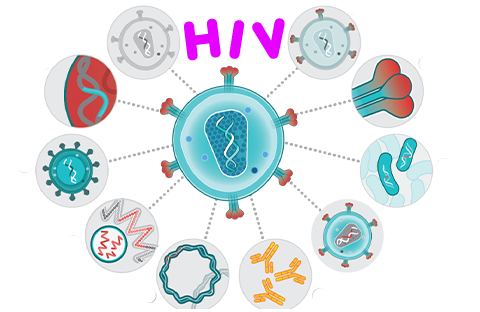HIV AND PREP IN 2024

HIV and Prep In 2024
Hello visitors of Twink Boys, today we will be discussing a very important topic – HIV and PrEP. HIV, which stands for Human Immunodeficiency Virus, is a virus that attacks the immune system and can lead to AIDS (Acquired Immunodeficiency Syndrome). It is a global health issue that has affected millions of people worldwide and continues to be a major concern. HIV is transmitted through various ways, including unprotected sexual contact, sharing needles or syringes, and from an HIV-positive mother to her child during pregnancy, birth or breastfeeding.

It can also be transmitted through blood transfusions, although this is rare in developed countries where blood is screened for HIV. Once a person is infected with HIV, the virus attacks the immune system, specifically the CD4 cells which are responsible for fighting off infections and diseases. As the virus replicates, it gradually destroys these cells, making the immune system weaker and unable to defend the body against infections.
This is why people living with HIV are more susceptible to opportunistic infections and cancers. HIV has been a major public health concern since its discovery in the 1980s. It has led to millions of deaths and has affected countless lives. However, with advancements in medicine and technology, HIV is no longer a death sentence. People living with HIV can now live long and healthy lives with the help of antiretroviral therapy (ART). ART is a combination of medications that suppress the virus, allowing the immune system to recover and prevent the progression of HIV to AIDS.
But what if there was a way to prevent HIV infection altogether? This is where PrEP comes in. PrEP, which stands for Pre-Exposure Prophylaxis, is a daily pill that can be taken by people who are at a high risk of contracting HIV. It is a combination of two antiretroviral drugs – tenofovir and emtricitabine – that work by blocking the virus from replicating and spreading in the body.
PrEP has been proven to be highly effective in preventing HIV when taken consistently and correctly. In fact, studies have shown that PrEP can reduce the risk of getting HIV by up to 99% when taken as prescribed. It is a game-changer in the fight against HIV and has the potential to greatly decrease the number of new HIV infections.

So who should consider taking PrEP? Anyone who is at a high risk of getting HIV, such as men who have sex with men, transgender individuals, sex workers, and people who inject drugs, can benefit from PrEP. It is also recommended for HIV-negative individuals who are in a serodiscordant relationship, where one partner is HIV-positive and the other is not.
It is important to note that PrEP is not a one-time thing. It needs to be taken every day to provide maximum protection against HIV. It is also not a preventative measure for other sexually transmitted infections (STIs), so it is important to continue practising safe sex and getting tested regularly for STIs.
PrEP is now widely available in many countries, including the United States, and can be obtained through a prescription from a healthcare provider. In some places, it is also available for free or at a reduced cost through government programs and community health centers.
In conclusion, HIV and PrEP are two important topics that need to be discussed openly and without stigma. HIV is a manageable condition, and PrEP is a highly effective tool in preventing HIV infection. It is important for everyone to educate themselves about HIV and PrEP and to have open and honest conversations about sexual health. Remember, knowledge is power, and by staying informed, we can take control of our sexual health and help end the HIV epidemic. Thank you for reading and stay safe!

HIV and Prep In 2024 – What Are HIV & Prep?
In the year 2024, HIV and PrEP (Pre-exposure prophylaxis) are two terms that have become increasingly common in discussions about sexual health and prevention of HIV transmission. But what exactly are HIV and PrEP, and how are they related? In this article, we will delve into the details of these two important concepts.
HIV (Human Immunodeficiency Virus) is a virus that attacks the immune system, specifically the CD4 cells, which are crucial for fighting infections and diseases. If left untreated, HIV can progress to AIDS (Acquired Immunodeficiency Syndrome), a condition in which the immune system is severely compromised and the body is vulnerable to opportunistic infections. HIV is primarily transmitted through the exchange of certain bodily fluids, such as blood, semen, vaginal fluids, and breast milk. This can happen through unprotected sexual intercourse, sharing needles or syringes, and from mother to child during pregnancy, childbirth, or breastfeeding.

In 2024, it is estimated that around 38 million people globally are living with HIV, with the majority of them residing in low- and middle-income countries. Despite advances in treatment and prevention, HIV continues to be a major public health concern, leading to about 1.7 million new infections and 690,000 deaths in 2019 alone. However, with the development of effective antiretroviral therapy (ART), people living with HIV can now lead long and healthy lives.
On the other hand, PrEP is a preventive strategy that involves taking a daily pill containing two antiretroviral drugs, tenofovir and emtricitabine. When taken consistently, PrEP has been shown to be highly effective in preventing HIV transmission. It works by blocking the virus from establishing a permanent infection in the body, thus reducing the risk of HIV transmission. PrEP is recommended for people at substantial risk of acquiring HIV, including those with multiple sexual partners, men who have sex with men, and individuals who inject drugs.
In 2024, PrEP has become more widely available and accessible, with various countries implementing programs to provide PrEP to those who need it. However, there are still barriers to access, such as cost and awareness, which need to be addressed in order to reach more individuals who can benefit from PrEP.
So, how do HIV and PrEP intersect? PrEP is a preventive measure against HIV, and its availability has the potential to significantly reduce new HIV infections. It is particularly beneficial for individuals who engage in high-risk behaviors and those who have partners living with HIV. However, PrEP is not a replacement for other prevention methods, such as using condoms and regular testing for HIV. It is important to note that PrEP only protects against HIV and does not prevent other sexually transmitted infections (STIs) or unintended pregnancies.
Furthermore, PrEP is not a cure for HIV. It is a preventive measure that needs to be taken consistently to be effective. If someone on PrEP does acquire HIV, it is crucial to seek medical attention immediately to start on ART and prevent the virus from developing resistance to the drugs.
In conclusion, HIV and PrEP are two important components in the fight against HIV transmission. In 2024, they play a vital role in reducing the number of new infections and improving the quality of life for those living with HIV. However, it is essential to continue raising awareness about HIV and PrEP, addressing barriers to access, and promoting comprehensive sexual education to further prevent new HIV infections. With continued efforts and advancements, we can hope to see a significant decline in HIV transmission in the future.
HIV and Prep In 2024
HIV, or human immunodeficiency virus, is a virus that attacks the body's immune system, specifically the CD4 cells which are responsible for fighting off infections. Without treatment, HIV can lead to AIDS, or acquired immunodeficiency syndrome, which is a weakened immune system that leaves the body vulnerable to infections and diseases.
In 2024, HIV remains a major global health issue, with an estimated 38 million people living with the virus worldwide. However, significant progress has been made in the prevention and treatment of HIV, particularly with the introduction of PrEP.
PrEP, or pre-exposure prophylaxis, is a medication regimen that is taken by people who are at high risk of contracting HIV. It is a combination of two antiretroviral drugs, tenofovir and emtricitabine, which work by blocking the virus from replicating in the body. When taken consistently, PrEP has been shown to reduce the risk of HIV infection by over 90%.
In 2024, PrEP has become increasingly accessible and widely used, particularly in high-risk populations such as men who have sex with men, transgender individuals, and people who inject drugs. This is thanks to the efforts of organizations and governments to increase awareness and affordability of PrEP.
One major development in the use of PrEP in 2024 is the availability of generic versions of the medication. This has significantly reduced the cost of PrEP, making it more accessible to those who may not have been able to afford it previously. In addition, many countries have included PrEP in their national healthcare programs, making it available at little to no cost for those who need it.
Another major milestone in 2024 is the development of long-acting PrEP options. This includes an injectable medication that is administered every two months, as well as a vaginal ring that is inserted once a month. These options provide an alternative to the daily pill regimen, which may be more convenient for some individuals.
In addition to the use of PrEP, 2024 has also seen advancements in HIV treatment. Antiretroviral therapy, or ART, is the standard treatment for HIV, and it has become more effective and tolerable with new medications being developed. This has also contributed to the decrease in new HIV infections, as people living with HIV who are on ART are less likely to transmit the virus to their sexual partners.
However, despite these advancements, there are still challenges that remain in the fight against HIV. Stigma and discrimination against people living with HIV continue to be barriers to prevention and treatment efforts. In addition, there are still significant disparities in access to PrEP and treatment, particularly in low and middle-income countries.
In conclusion, while there have been significant developments in the prevention and treatment of HIV in 2024, there is still much work to be done. It is important for governments, organizations, and individuals to continue advocating for increased access to PrEP and treatment, as well as addressing the underlying issues of stigma and discrimination. With continued efforts, it is possible to achieve the goal of ending the HIV epidemic.
HIV and Prep In 2024 – Free In Europe
In 2024, the world will have come a long way in its fight against HIV. Thanks to advancements in medical research and technology, HIV prevention and treatment methods have significantly improved, and the number of new infections has been on a steady decline. However, while some countries are making great strides towards achieving a HIV-free future, others are still struggling to provide access to life-saving medication. In particular, the availability and affordability of Pre-Exposure Prophylaxis (PrEP) in the United States remains a contentious issue, despite being offered for free in Europe.
So, what exactly is HIV and PrEP, and why is there such a stark contrast between the US and Europe when it comes to access and cost?
HIV, or Human Immunodeficiency Virus, is a virus that attacks the immune system, making it difficult for the body to fight off infections and diseases. If left untreated, HIV can progress to AIDS (Acquired Immunodeficiency Syndrome), which is the final stage of HIV infection and can be fatal. It is primarily transmitted through unprotected sexual intercourse, sharing needles, and from mother to child during pregnancy, birth, or breastfeeding.
Since its discovery in the 1980s, HIV has claimed millions of lives worldwide. However, with the advent of antiretroviral therapy (ART), which is a combination of drugs that suppress the virus, people living with HIV can now lead long and healthy lives. ART also plays a crucial role in preventing the transmission of HIV to others.
On the other hand, PrEP is a daily pill that is taken by HIV-negative individuals to reduce their risk of contracting the virus. The pill contains two anti-HIV drugs, tenofovir and emtricitabine, which work by blocking the virus from establishing a permanent infection in the body. When taken consistently as directed, PrEP has been shown to be up to 99% effective in preventing HIV transmission.
The World Health Organization (WHO) recommends PrEP as a vital part of a comprehensive HIV prevention strategy, along with condom use, regular testing, and access to ART for those living with HIV. In 2012, the United States Food and Drug Administration (FDA) approved the use of PrEP for HIV prevention, making it the first country to do so. Since then, several other countries, including those in Europe, have also approved the use of PrEP.
In Europe, PrEP is readily available and free of charge in most countries. The European Centre for Disease Prevention and Control (ECDC) has published guidance on the use of PrEP, and many countries have implemented national programs to ensure access to the medication. In countries like France, Belgium, and Scotland, PrEP is available at no cost to individuals at high risk of HIV, such as men who have sex with men and people who inject drugs.
However, in the United States, PrEP is still not easily accessible or affordable for many individuals. Despite the FDA approval, the high cost of the medication, which can range from $1,300 to $1,500 for a month's supply, has been a major barrier for many people. This is due to the lack of generic versions of the drug, which would make it more affordable. In addition, insurance coverage for PrEP is not consistent, with some plans covering it fully while others requiring high out-of-pocket costs.
As a result, the United States has seen a significant disparity in PrEP use, with the majority of users being white, affluent, and urban. This has raised concerns about the widening gap in HIV prevention and treatment among different socioeconomic groups. In 2019, the Centers for Disease Control and Prevention (CDC) estimated that only 18% of the estimated 1.2 million Americans who could benefit from PrEP were actually using it.
Several efforts have been made to increase access to PrEP in the United States, such as the Ready, Set, PrEP program, which provides free medication to eligible individuals. However, these initiatives are limited in scope and do not fully address the underlying issue of affordability.
In conclusion, while Europe has made significant progress in offering free and accessible PrEP, the United States is still facing challenges in providing affordable access to this life-saving medication. As we approach 2024, it is crucial for policymakers and healthcare providers in the US to address these disparities and ensure that PrEP is available to all who need it. HIV should not be a disease that only the wealthy can afford to prevent and treat. Everyone, regardless of their socioeconomic status, deserves the right to a healthy and HIV-free future.
Unlock your full potential in the bedroom with ExtenZe Pills! the leading male enhancement pill with over 1 billion pills sold, proven to deliver bigger, harder, and more frequent erections. Say goodbye to flat performance and hello to massively intense and electrifying orgasms. with increased endurance, keep the passion going for longer-lasting sessions. Don't wait any longer, experience the ultimate pleasure and satisfaction with ExtenZe Pills today!







